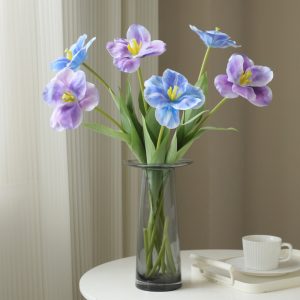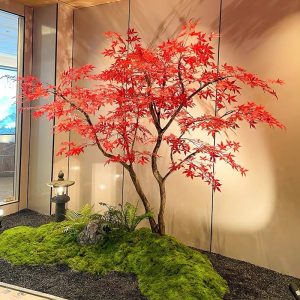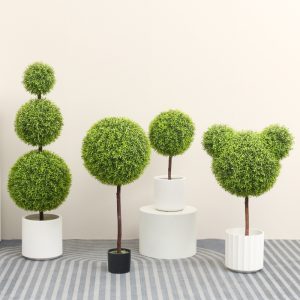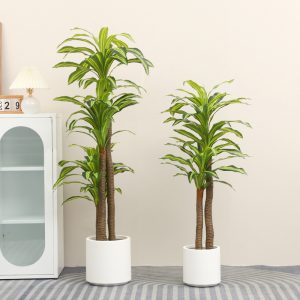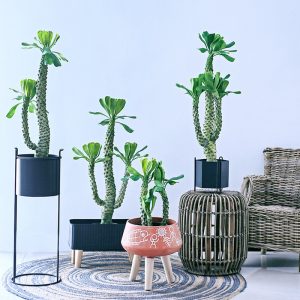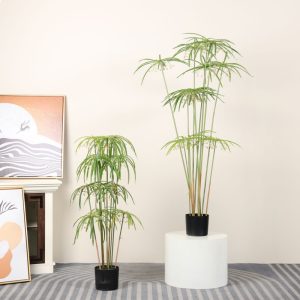At 8 AM in the Westin Hotel’s courtyard lounge in Boston, sunlight streams through the glass roof, casting dappled light on the oak floor of the lobby. My colleague Jake stands by the flowerbed next to the revolving door, gently brushing an orange-red leaf, and turns to me with surprise: “Look at the gradient of color in the sunlight, from orange-yellow to deep red. It’s even more captivating than the real maple trees on Canada’s Maple Leaf Avenue. Who would have thought this is an artificial red maple tree the hotel is using?” The air is filled with the scents of cinnamon and roasted pumpkin, and this vibrant red adds autumn warmth to the modern space.
As I push open the hotel’s glass doors, the first thing that catches the eye are two artificial red maple trees, each standing at 2.8 meters tall. The one on the left stretches its branches toward a vintage chandelier, with leaves almost touching the crystal tassels; the one on the right rests beside a beige sofa, creating a cozy corner. Jake bends down to examine the leaves and smiles, pointing to the leaf edges: “Look at the serrated edges of the leaves, the shadows in the sunlight are just like real maple leaves. Last week, a client from Toronto circled the tree three times and said, ‘It feels like we’ve brought the autumn forest into the hotel.’”
The lobby furniture is a classic combination of dark walnut and light gray leather, and the artificial red maple trees add a touch of life. When the midday sun is strong, the leaves cast shifting shadows on the walls; in the evening, the warm lights turn the red-orange leaves into an amber glow. Clara, the soft furnishings manager, walks by with a coffee: “We tried planting real red maples before, but Boston’s autumn is brief. Within a month, the leaves would be all over the floor, and housekeeping had to clean up several bags of leaves daily. After switching to these artificial red maple trees, we saved on weekly maintenance costs. A quick dusting with a feather duster keeps the leaves clean.”

We move to the central lounge area of the lobby, where the artificial red maple trees are planted in bronze planters. “Notice anything?” Jake points to the branches, “The branches aren’t rigidly symmetrical; they naturally curve, and the knots on the trunk are clearly visible. This morning, a bride took pre-wedding photos here, and the photographer said this tree looks even better on camera than real trees, unaffected by the wind.” A guest with a rolling suitcase walks past, pauses by the tree to adjust their scarf, and their phone camera focuses on the red leaves, the corners of their mouth lifting in appreciation of the autumn scene.
“We debated for a month when selecting the plants,” Jake leads me to the elevator hall decor area, where the artificial tree is paired with a wooden plant stand, contrasting with the autumn-themed oil paintings. “Headquarters wanted to ‘evoke emotional resonance with a sense of the season,’ but North American hotels face insufficient light in the fall and winter, and the climate is dry. Real red maples can’t survive the cold, and would need to be replaced frequently, which makes labor costs too high.” He stands on tiptoe to touch the higher leaves, “When we saw the sample, we were amazed. This UV-resistant material withstands the dryness of heated rooms, and the leaf-droop angle looks just like a real red maple that’s been growing for five years.”
Mike from the engineering department walks by with a toolbag and joins the conversation: “I kept a close eye on the installation, and it was much easier than I thought. The bottom has a hidden counterweight, so it stays steady even in strong winds or snowstorms. The best part is the environmental benefits. No need for pesticides like with real plants, and we can confidently use them in guest rooms.” He points to the hallway corner decor: “Last week, a client from Chicago took a photo of the bark texture and wanted to use it as inspiration for a restaurant design. They even asked if it was customized by a Canadian horticulturist.”
Sophie from the purchasing department walks over, flipping to the maintenance cost page: “We used to spend $700 per month on fertilizer and pruning for real trees, not to mention the cost of seasonal replacements. After switching to the artificial red maple trees used in the hotel, we saved that money, and guest satisfaction surveys showed an 18% increase in ‘environmental comfort’ scores.” She points to a customer comment: “This one: ‘The red maple tree in the lobby made me feel like I was stepping into my hometown’s autumn as soon as I walked in. It erased all my travel fatigue,’ which is exactly the effect we were aiming for.”
In the afternoon, sunlight filters through the blinds onto the artificial red maple tree by the window in the executive lounge. A few business clients are having a discussion, with a mini decoration on the table making the conversation feel relaxed. Jake whispers, “Notice anything? Compared to plastic fake plants, this has absolutely no ‘cheap’ feel. The leaves range from dark to light, with the red-orange-yellow gradient appearing naturally. Guests don’t shy away from it; in fact, they touch it as if it were a real tree.”
Maria from the housekeeping department rolls a laundry cart past: “The small artificial red maple trees in the guest rooms are the most popular! Especially in north-facing rooms, where real trees never did well, now we use these artificial ones, and guests often ask where they can buy one when they check out. Once, a guest from Seattle specifically asked for care instructions, saying they wanted to place one in their home study.” She points to the suite’s entryway: “We adjust the planter according to the room style: for modern rooms, we use concrete planters; for vintage styles, we pair them with wicker baskets. Guests say it feels like living in a villa with a private garden.”
In the bustling evening restaurant, the hotel’s artificial red maple trees extend along the edges of the dining counters. Chef Paul walks by with a tasting plate: “Last week, a guest thought it was a real tree and asked if the leaves could be used to decorate pumpkin pie. I told them it was our hotel’s artificial red maple tree. They didn’t believe me until they leaned in to smell it.” The restaurant’s warm lighting reflects off the red-orange leaves.
Late at night, the hotel quiets down, and the duty manager dims the lights. Moonlight streams through the window, casting a silver sheen over the artificial red maple tree. Jake watches the red leaves gently sway in the breeze: “What travelers miss most is the emotional connection that comes with the seasons. These artificial red maple trees, which require no maintenance yet retain their autumn appearance year-round, have become the hotel’s most understanding partner.”
When the morning light once again illuminates the streets of Boston, the artificial red maple trees in the lobby still stand tall, welcoming each guest. In a city covered by snow for half the year, these eternal red leaves decorate the space, conveying the warmth of autumn.







